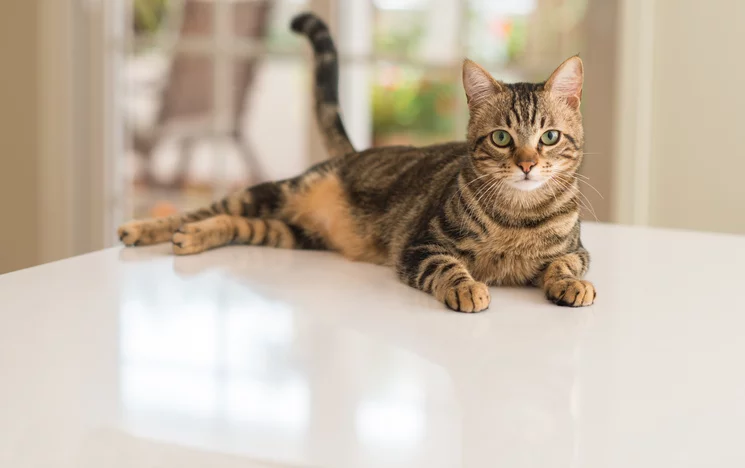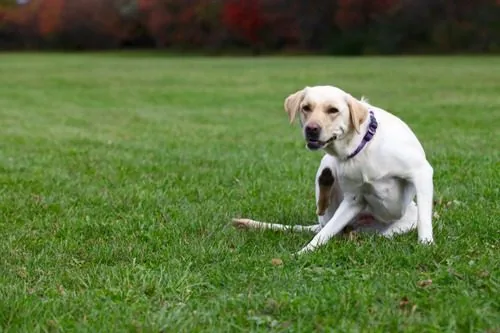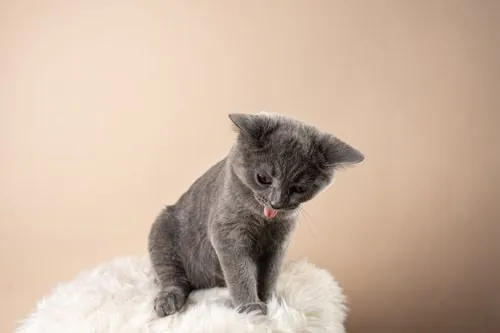Cat Tail Wagging: What Does it Mean?
Have you ever seen your cat wagging her tail back and forth? Or have you noticed her twitching it from side to side and you find yourself wondering what these feline tail behaviors might mean? Whether you’re new to cat ownership or you’re experienced with many past feline friends, it’s important to learn everything you can about your cat’s behavior.

What is Causing My Cat’s Tail Wagging?
Tail communication is a major part of your cat’s body language. By brushing up on it, you can better understand what your cat needs and what she is feeling at any given time. Below are some of the reasons why your cat is wagging his tail.
Comfort and Contentment
More often than not, a cat with a sweeping tail wag is a happy, comfortable, and content cat. She may run to meet you at the door when you get home from work, happy to see you, and may hold her tail high behind her back. While doing this, she may allow her tail to wag back and forth gently. This motion is different from the way a dog wags its tail, but it is also slightly similar in some ways. It is an indication that your cat is in a good mood.
Some cats may not ever do this, and that’s okay, too. These cats may be more prone to simply holding their tails straight up, pointing at the sky or slightly crooked at the end, to show the same mood. Just because your cat doesn’t wag her tail when she’s happy doesn’t mean there’s anything wrong with her. On the other hand, tail wagging out of happiness is completely normal and isn’t a cause for concern, either. A healthy, happy cat may do this several times a day, and it is likely to become a common sight in your cat-friendly home.
Hunting and Preparing to Pounce
If you’ve ever seen your cat hunting a favorite toy or getting ready to pounce on an object, you’ve likely noticed her hunching close to the ground and wiggling her body back and forth to get into a good position. When doing this, some cats may also wag or twitch their tails quickly. This shows that they are paying close attention to whatever they are focusing on.
This behavior from your cat is normal and is nothing to worry about. As long as your cat is getting ready to chase or jump on a toy and not another pet or a human family member, this behavior should not be interrupted or corrected.
Spraying and Marking
Male cats, especially those who have not been neutered, may twitch their tails very quickly back and forth while holding them high in the air. This is an indication that they are spraying or marking their territory. This is usually followed with a visible wet mark on your furniture or walls.
Even some male cats who have been neutered will still perform this behavior instinctively, without any wetness as a result. It is simply part of being a male cat, and it something to consider when you’re thinking of adopting a male cat.
Irritation and Frustration
Cats who sit with their backs to you and twitch their tails back and forth in small motions against the floor are often irritated. They may be upset that someone or something is getting in their personal space. Another reason is they may be frustrated that no one will give them a treat or let them jump on the counter. Usually, a cat can calm down from this state on her own. However, it’s still a good idea to give her a little extra room in this situation.
Anger and Attacking
The wagging of an angry cat’s tail is significantly different from this behavior when associated with other feelings and experiences. If your cat’s tail is swishing back and forth in large movements, usually while being held against the floor, this is a good indication that she is getting angry & stressed.
A cat whose tail has been wagging like this and suddenly stops, is probably about to attack. In most cases, your cat will have the appearance of very wide eyes and flat ears. It is best that you back away from your cat and give her plenty of space to calm down.
Pay Attention To Your Cat’s Tail Wagging
By paying attention to your cat’s tail, you can recognize many different distinct, subtle changes in her behavior, feelings, mood, and needs. Your cat’s tail can tell you a lot about what she’s experiencing, so learn how to notice the difference between tail positions and motions as soon as possible.
The more you come to understand about your cat and her body language, the better off both of you will be. You’ll learn how to get along with each other better, and you’ll know what your cat needs without having to guess, too. It’s a win-win for both of you! If you have any further questions or concerns about your cat’s tail wagging, contact our team at The Village Vets today!
Recent Posts
About The Village Vets
The Village Vets is a network of animal hospitals based in Atlanta, GA and the surrounding area. We offer honest, excellent service to our clients in a comfortable, friendly atmosphere. To learn more about our locations and how we can better serve you and your pet, click the button below.
Share This Post
Recent Posts
About The Village Vets
The Village Vets is a network of animal hospitals based in Atlanta, GA and the surrounding area. We offer honest, excellent service to our clients in a comfortable, friendly atmosphere. To learn more about our locations and how we can better serve you and your pet, click the button below.



